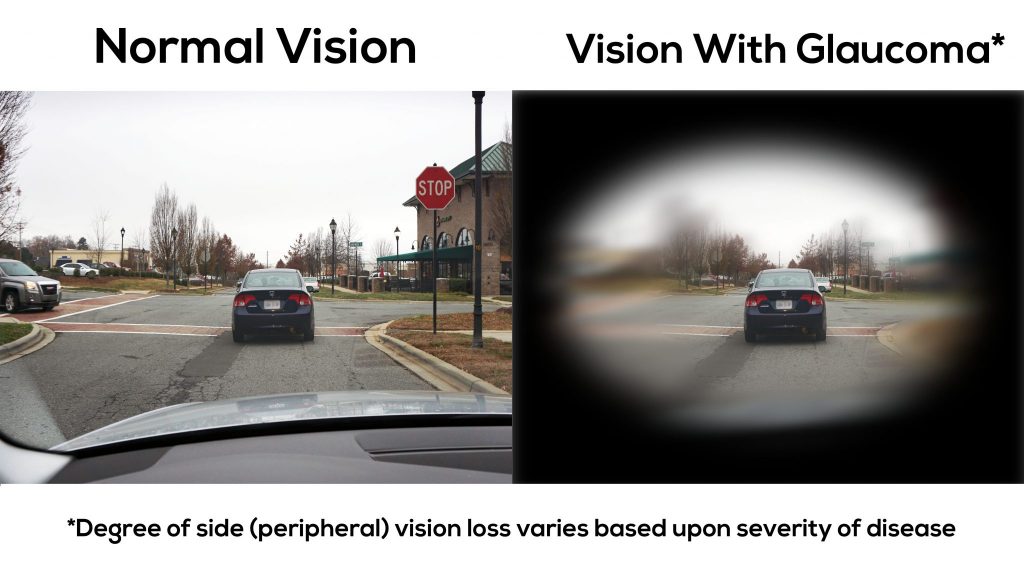Glaucoma
Glaucoma is the name given to a group of eye diseases that all result in irreversible damage to the optic nerve.
Glaucoma is the name given to a group of eye diseases that all result in irreversible damage to the optic nerve. This damage progresses very slowly and destroys vision gradually, starting with side (peripheral) vision. The damage is both irreversible and progressive.
It is the second most common cause of blindness worldwide, globally affecting more than 60 million people. In Australia, glaucoma is one of the leading causes of irreversible blindness. It is estimated that over 300,000 Australians have glaucoma, but 50% are undiagnosed. This is largely due to the fact that glaucoma is generally asymptomatic with no early warning signs. A considerable amount of peripheral vision is usually lost before there may be any awareness of a problem.
In patients with glaucoma, the optic nerve can be sensitive to intraocular pressure (IOP) even when the IOP is normal (between 10 – 21 mmHg). While glaucoma is a leading cause of blindness in people over 40, it can affect people at any age.

Key Points:
- Known as the ‘sneak thief of sight’ glaucoma develops slowly and often without symptoms.
- Early detection and adherence to treatment are vital to slow glaucoma progression.
- Glaucoma is hereditary – you are 10X more likely to develop glaucoma if you have a direct family member with glaucoma.
Who is affected?
Although anyone may develop glaucoma, some people are at a higher risk. Risk factors include:
- A family history of glaucoma (first-degree relatives)
- High eye pressure
- Age over 50
- African or Asian ethnicity
- Diabetes
- Short or long sightedness
- A previous history of eye injury
- Past or present prolonged use of cortisone drugs (steroids)
- Migraine
- High or low blood pressure
- Obstructive sleep apnoea
Types of Glaucoma
Glaucoma is the name given to a number of different conditions with the end result being irreversible damage to the optic nerve. Below are some of the more common glaucoma sub-types:
Primary open angle Glaucoma
This is the most common form of the disease. It is characterised by a structurally normal eye with potentially raised intraocular pressure inside the eye.
Angle-closure Glaucoma
This is when the pressure inside the eye rapidly increases due to the iris blocking the drainage of fluid in the eye. An attack of acute closure is often severe. People suffer pain, nausea, blurred vision and redness of the eye. Immediate medical help should be sought. If treatment is delayed, there can be permanent visual damage in a very short time. Usually, laser surgery performed promptly can clear the blockage and protect against visual impairment.
Congenital Glaucoma
This is a rare form of glaucoma caused by a congenital malformation of the drainage system. It can exist at birth or develop soon after. Parents may note that their child is sensitive to light, has enlarged and cloudy eyes, and experiences excessive watering. Surgery is always needed.
Secondary Glaucoma
This can develop as a result of other disorders of the eye such as injuries, cataracts and eye inflammation. Treatment depends on the exact cause.
Glaucoma Treatment Options
The first step in the management of glaucoma is identifying the disease and assessing how slowly or rapidly the disease is progressing.
This will involve a check of your vision, intraocular pressure and assessment of the drainage angles of the eye. A structural analysis of the optic nerve head (Optical Coherence Tomography) and an assessment of optic neve functioning (Visual field analysis) will be performed at regular intervals. Each of theses tests are all essential to assess how well your optic nerve is functioning and how much damage has occurred.
Although there is no cure for glaucoma it can usually be controlled so that further loss of sight can be prevented or slowed. Treatment for glaucoma consists of eye drops, laser treatment, surgery or a combination of the three. It is important to remember that treatment cannot recover what has been lost. Treatment aims to arrest, or at least, slow down the damage process. That is why it is so important to detect the problem as early as possible. This allows us to start treatment with as little damage to the vision as possible. All current glaucoma treatments lower the eye pressure to a level where your glaucoma doesn’t get worse. This may take time to establish.
Eye Drops
The vast majority of people are treated with eye drops that they take indefinitely, either once a day or twice a day. Sometimes the first drop that you try may not be right for you and your doctor will prescribe an alternative. Some people need to be on 2 or 3 types of eye drops.
Laser Treatment
A number of laser treatment options are available for glaucoma depending on the type of glaucoma present. Two of the more commonly performed lasers are described below:
- Selective Laser Trabeculoplasty (SLT): Generally used to lower IOP for Primary Open Angle Glaucoma. SLT uses short pulses of low energy light on the drainage angle to assist with better outflow of aqueous fluid.
- Peripheral Iridotomy (PI): Generally used to lower IOP for Angle-Closure Glaucoma. A laser is used to create a small hole in the peripheral iris, which assists in the flow of the aqueous fluid to the drainage angle.
Surgery
A number of surgical procedures are available. A decision will be made with your ophthalmologist about the best surgical choice in your eyes.
- Trabeculectomy: A tiny flap is created in the white part of the eye and a filtration bleb (like a pocket) is formed under the conjunctiva. Both are hidden under the top eyelid. The aqueous humour is able to drain out of the eye through the flap and then into the bleb where is it absorbed – lowering the IOP in the eye.
- Minimally Invasive Glaucoma Surgery (MIGS): MIGS procedures work by bypassing the blockage in the drainage angle and helping the fluid inside the eye drain out via different routes. This is often performed in combination with cataract surgery.
- Glaucoma drainage devices: This involves the insertion of a drainage reservoir in the eye.
For further information, please vision the Glaucoma Australia website.
